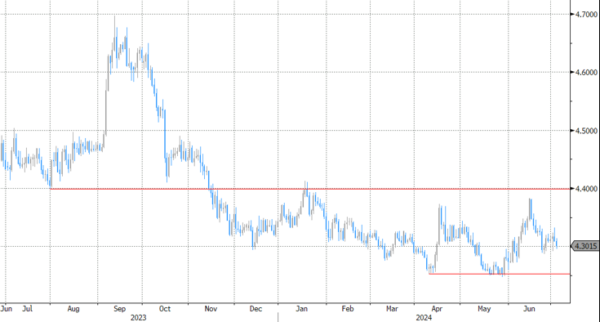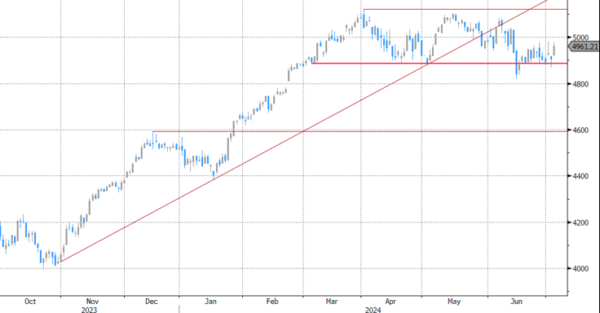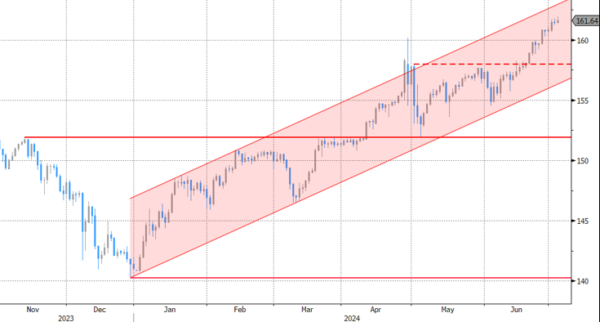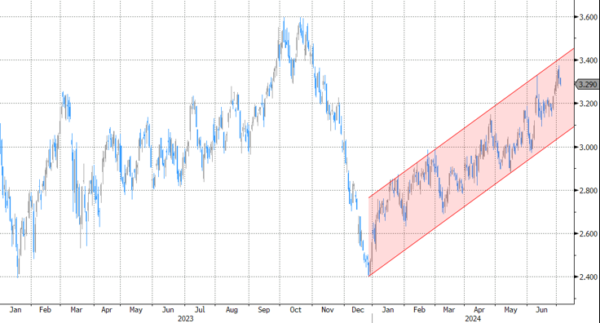Markets
European markets today enjoyed some kind of a risk-on catch up move. A record close of the US S&P 500 above the 5500 mark yesterday apparently also inspired European investors (Eurostoxx 50 +1.3%). On French/intra-EMU bond markets, the risk premia also narrowed slightly further. The French 10-y spread over Bunds eased to 68 bps vs 74 bps two days ago and a peak of 82 bps last week. It suggests that the ‘Republican Front’ of the left-wing Nouveau Front Populair and President’s Macron’s Ensemble withdrawing more than 200 candidates from Sunday’s ballot to join forces, is seen as reducing the prospect for the Rassemblement National securing an absolute majority, in turn also tempering the risk of fiscal profligacy. Even so, the risk-on repositioning had only modest directional impact on European interest rate markets. German Bund yields are varying between +2.5 bps (2-y) and -3 bps (30-y) in a daily perspective (before the release of the US services ISM), tentatively backtracking on recent steepening move. Bunds also slightly underperform swaps. US markets still had some data to cope with going into an early close ahead of tomorrow’s 4th of July national holiday. Printing a 150k June job growth, the ADP private labour market report was marginally softer than expected (consensus 165k) and this also was the case for the jobless claims (initial claims 238k vs 235k expected, continuing claims raising further to 1858k, the highest since end 2021). US yields lost 2-3 bps across the curve after the data. In an appearance at the ECB symposium at Sintra NY Fed Williams didn’t join the recent ‘popular’ analyses of a higher neutral rate post the pandemic. He doesn’t see a U-turn in the longstanding decline in the R-star, but the high degree of uncertainty about the concept means one should not overly rely on it when setting appropriate monetary policy at a given point in time.
At time of finishing this report, the US services ISM fell off a cliff unexpectedly tumbling in contraction territory (48.8 from 53.8 vs 52.7 expected) with new orders (47.3 from 54.1) indicating more trouble ahead. Employment also eased further in contraction territory. Still prices paid remain elevated at 56.3. After modest declines in the wake of the softer labour market data, US yields extended decline to 5-7 bps across the curve.
Major FX cross rates mostly hold within established ranges. The European risk-on and softer US data help EUR/USD extending its rebound within the ST 1.0666/1.0916 trading range (1.08 from 1.0745). DXY retreats further from the 106+ area tested last week. The yen continues its negative record race even against a weaker dollar, with USD/JPY reaching the highest level since December 1986. Question remains was pace of decline Japanese authorities see as too disorderly to warrant FX interventions. No pre-election stress for sterling, with the UK currency even gaining a few ticks against a well-performing euro (EUR/GBP 0.8465).
News & Views
The Swedish services PMI rebounded more than expected in June, bouncing back to growth (51.8) following two months in contractionary territory. Details were encouraging. Accelerating new orders (52.5) suggest that business volumes will increase from the current modest expansion (50.2). Planned business volumes effectively point to stronger growth (55.5). Firms held the employment status quo (50.1) after downsizing in May. Simultaneously, the disinflationary trend in suppliers’ input prices is extended (53.7 from 54.2), giving backing to the Riksbank’s policy guidance of two or three more policy rate cuts this year. The Swedish krone is a tad stronger at EUR/SEK 11.35.
News agency Reuters suggests that (at least) six ECB policy makers are urging a review of the aggressive monetary stimulus policies the ECB employed for nearly a decade to tackle low inflation, judging that they may have done more harm than good. Especially the massive liquidity injection via asset purchases is under scrutiny. The Bank of International Settlements in its recent annual review also questioned the debate about QE’s effectiveness. Especially when it is used intensively and for very long to respond to long-term issues which should actually be tackled by governments rather than central banks. The now symmetric 2% inflation target could help avoiding the same mistakes in the future.
Graphs
EUR/PLN zloty well protected as NBP confirms hawkish hold.

Eurostoxx 50 rebounds as EMU risk premia ease as France’s Republican Front joins forces.

USD/JPY: yen at 38-year low as Japanese authorities stay sidelined for now.

French 10-y yields eases of the second consecutive day as countdown to second round of elections continues.










